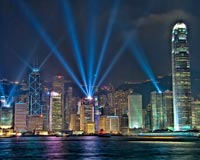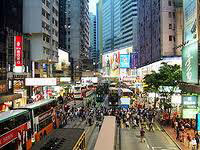 A neon blue glow lit up the waters of Hong Kong harbour at the start of this year, a result of algal blooms feeding in the increasingly polluted water.
A neon blue glow lit up the waters of Hong Kong harbour at the start of this year, a result of algal blooms feeding in the increasingly polluted water.
Like many new phenomena in Hong Kong, the appearance of Noctiluca scintillans – commonly known as Sea Sparkles – has been blamed on the Chinese mainland.
Pollution from the densely populated Pearl River Delta region on China’s southern coast regularly shrouds the island’s iconic skyline in a thin haze.
Mainland Chinese influence (and resentment of it) is on the rise in Hong Kong, illustrated by the Occupy Central protests that began last autumn, following the government’s move to ensure only Beijing-approved candidates could stand for election.
Concerns over the perceived deluge of mainland buyers inflating residential prices have also been high on the agenda for some time. These concerns have prompted the Hong Kong government, in 2013, to introduce a tough new stamp duty regime that is designed to discourage overseas investors.
So 18 years on from the handover of Hong Kong by the British and the creation of the “one country, two systems” principle, what effect is the rise of China having on Hong Kong’s commercial property market and what impact will the charged politics have on the city’s investment prospects?
Tied to China
“The big driver of growth for Hong Kong historically has been the US,” says Dennis Ma, JLL Hong Kong head of research. “But increasingly these days is it more tied to the Chinese economy.”
Take-up of commercial office space has been muted in the past couple of years, languishing at around 700,000 sq ft last year compared with a long-term average of 2m sq ft, according to JLL data.
The one occupier sector that was active, however, was mainland Chinese companies, which accounted for more than 20% of all lettings in 2014, albeit with smaller requirements. The result is that they took 15% of the total space leased.
“They tend not to be large space users but there has been a steady flow of demand and they now populate a reasonable portion of Hong Kong office space,” says Gavin Morgan, JLL Hong Kong chief operating officer and head of leasing.
“But it is getting more significant as time goes by and we expect mainland companies to be the big driver of demand in Hong Kong for the foreseeable future.”
The effect of the otherwise lacklustre demand has been limited, however. There is a relative supply drought, meaning vacancy rates actually dipped marginally, to 4.2%, in 2014.
Yields have remained tight and capital values have stayed high as the volume of stock coming to market has dropped significantly as a result of the doubling of stamp duty.
Hong Kong investment volumes were HK$37.7bn (£3.2bn) in 2012 and HK$38.3bn in 2013, the year stamp duty reforms were introduced.
In the first half of 2014, following the introduction of the new rules, JLL recorded just HK$11.3bn of investment transactions with a value of HK$20m or more.
Outbound investment
But the outlook for the investment market is changing, according to Joseph Tsang, managing director, JLL Hong Kong.
“I see outbound investment as more of a trend,” he says. “Because of the stamp duty increase and the cooling measures, introduced by the Hong Kong Monetary Authority to limit loan-to-value ratios, a lot of people are sitting on big chunks of money and thinking Hong Kong might not be the best place to invest.”
Add to that the prospect of US interest rate hikes – which, with the Hong Kong dollar pegged to the US currency, is widely expected to cause yields to move out – and many investors are already actively looking elsewhere.
 “People consider Hong Kong to be a little more risky, so they are talking about moving into the UK,” adds Tsang.
“People consider Hong Kong to be a little more risky, so they are talking about moving into the UK,” adds Tsang.
Billionaire tycoon Li Ka-shing has led this move away from domestic markets in search of bargains – and where he leads, many are expected to follow.
The 86-year-old investor recently restructured his empire (which includes Cheung Kong and Hutchison Whampoa), moving it offshore.
He followed up the restructuring with a £10bn bid for telecoms giant O2, a move analysts have interpreted as a reaction to slowing growth in China and the improving outlook and stable returns on offer in the UK.
But Andrew Moore, chief executive officer of Pamfleet, a $500m (£330m) Hong Kong fund manager, believes that reports of the decline of the domestically focused Hong Kong tycoons are premature.
“In no way is it the death of the tycoon. There are still plenty of tycoons around who back Hong Kong and the property market here,” he says. “For every one who is shipping money out of Hong Kong, there are plenty of others who are still active.”
While some investors may be looking overseas, there is no evidence of a lack of activity in the commercial development market.
“We are also about to move into a little supply boom,” says Morgan.
The long-run trend for new supply in Hong Kong is about 2m sq ft per annum, according to JLL.
But between now and 2018 some 11m sq ft is due to be delivered in Kowloon East – an emerging back-office market on the other side of the harbour – while a further 3m sq ft is planned across five new projects on Hong Kong island.
A new six-lane motorway connecting the prime office area Hong Kong Central with Hong Kong East – where Swire Properties owns about 8m sq ft of grade-A space and is developing another 2m sq ft will effectively double the size of the Hong Kong CBD, according to Morgan, and help Kowloon East to establish itself as a true back-office location.
The glut of new supply will prove a drag on rents but Morgan believes there will be a long-term benefit if Hong Kong can shake its “expensive” tag.
Tech occupiers, which have driven demand in London and New York, are largely absent from Hong Kong.
This is in part because some skilled young workers have been priced out of the market.
 But a series of new infrastructure projects connecting Hong Kong to the mainland will help to improve and expand the city’s commutable labour force, improving its attractiveness to tech occupiers.
But a series of new infrastructure projects connecting Hong Kong to the mainland will help to improve and expand the city’s commutable labour force, improving its attractiveness to tech occupiers.
A new bullet train between Kowloon East and the southern Chinese city of Shenzhen is under construction, as is a new bridge connecting Hong Kong to Zhuhai and Macau.
“Shenzhen is one of the tech hubs of China,” adds Morgan. “Being 20 minutes by train from all these important business districts and an area with a population of 40m people is going to increase headquarter opportunities in Hong Kong.”
Growing Chinese influence then is both a benefit and a source of tension.
The Occupy Protests may have provoked the widest debate yet about the success of the “one country, two systems” principle.
But with 32 years to go until the 50-year agreement expires, it seems likely the debate – and its impact on property markets – will only get louder.
jack.sidders@estatesgazette.com











